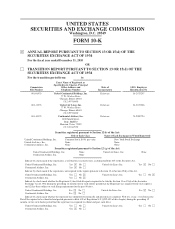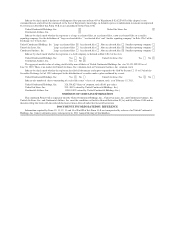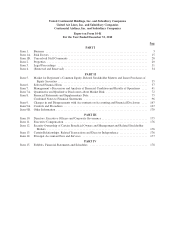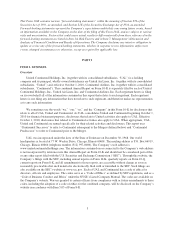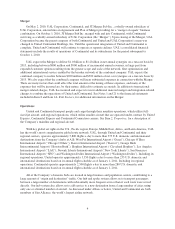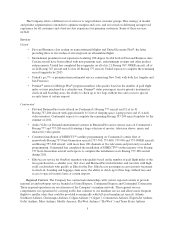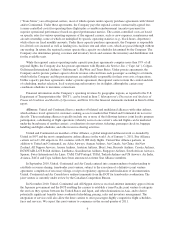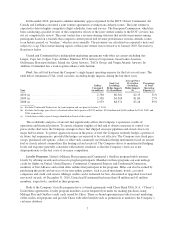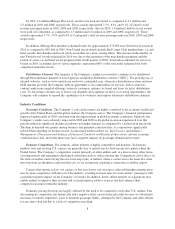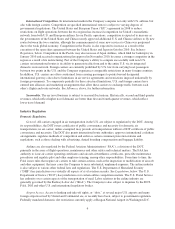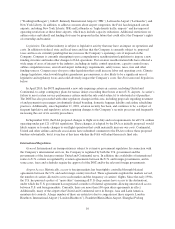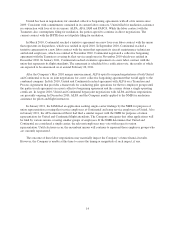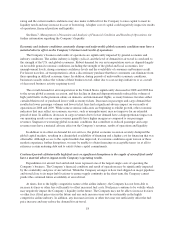United Airlines 2010 Annual Report Download - page 10
Download and view the complete annual report
Please find page 10 of the 2010 United Airlines annual report below. You can navigate through the pages in the report by either clicking on the pages listed below, or by using the keyword search tool below to find specific information within the annual report.In 2010, 2.4 million Mileage Plus travel awards were used on United, as compared to 2.1 million and
2.3 million in 2009 and 2008, respectively. These awards represented 7.5%, 8.3% and 9.1% of United’s total
revenue passenger miles in 2010, 2009 and 2008, respectively. Also in 2010, 1.6 million OnePass travel awards
were used on Continental, as compared to 1.3 million and 1.6 million in 2009 and 2008, respectively. These
awards represented 5.7%, 5.9% and 8.4% of Continental’s total revenue passenger miles in 2010, 2009 and 2008,
respectively.
In addition, Mileage Plus members redeemed miles for approximately 975,000 non-United travel awards in
2010 as compared to 885,000 in 2009. Non-United travel awards include Red Carpet Club memberships, car and
hotel awards, merchandise and travel solely on another air carrier, among others. The increase in the number of
non-United travel awards redeemed in 2010 was due to the expansion of the merchandise programs and the
launch of a new car and hotel award program in the fourth quarter of 2009. Total miles redeemed for travel on
United in 2010, including class-of-service upgrades, represented 86% of the total miles redeemed (for both
completed and future travel).
Distribution Channels. The majority of the Company’s airline seat inventory continues to be distributed
through the traditional channels of travel agencies and global distribution systems (“GDS”). The growing use of
internal websites, such as www.united.com and www.continental.com, alternative distribution systems and new
GDS entrants provides the Company with an opportunity to de-commoditize its services, better control its
content, make more targeted offerings, retain its customers, enhance its brand and lower its ticket distribution
costs. To encourage customer use of lower-cost channels and capitalize on these cost-saving opportunities, the
Company will continue to expand the capabilities of its websites and explore alternative distribution channels.
Industry Conditions
Economic Conditions. The Company’s costs and revenues are highly correlated to the economic health and
growth of the United States and the global markets the Company serves. The Company’s financial performance
improved significantly in 2010 consistent with the improvement in global economic conditions. Similarly, the
Company’s results were adversely impacted in 2009 and 2008 as the global recession experienced over this
period resulted in significant declines in industry passenger demand, accompanied by a reduction in fare levels.
The drop in demand was greater among business and premium cabin travelers, as corporations significantly
reduced their spending on business travel. As discussed further in Item 1A, Risk Factors, and in Item 7,
Management’s Discussion and Analysis of Financial Condition and Results of Operations, adverse economic
conditions have had, and in the future may have, negative impacts on passenger demand and revenue.
Domestic Competition. The domestic airline industry is highly competitive and dynamic. In domestic
markets, new and existing U.S. carriers are generally free to initiate service between any two points within the
United States. The Company’s competitors consist primarily of other airlines and, to a lesser extent, other forms
of transportation and emerging technological substitutes such as videoconferencing. Competition can be direct, in
the form of another carrier flying the exact non-stop route, or indirect where a carrier serves the same two cities
non-stop from an alternative airport in that city, or via an itinerary requiring a connection at another airport.
Carriers that operate as low cost carriers or that have lower cost structures achieved through reorganization
may be more competitive with the rest of the industry, resulting in lower fares for such carriers’ passengers with
a potential negative impact on the Company’s revenues. In addition, future airline mergers or acquisitions may
enable airlines to improve their revenue and cost performance relative to peers and thus enhance their
competitive position within the industry.
Domestic pricing decisions are largely affected by the need to be competitive with other U.S. airlines. Fare
discounting by competitors has historically had a negative effect on our financial results because we often find it
necessary to match competitors’ fares to maintain passenger traffic. Attempts by the Company and other airlines
to raise fares often fail due to a lack of competitive matching.
8

